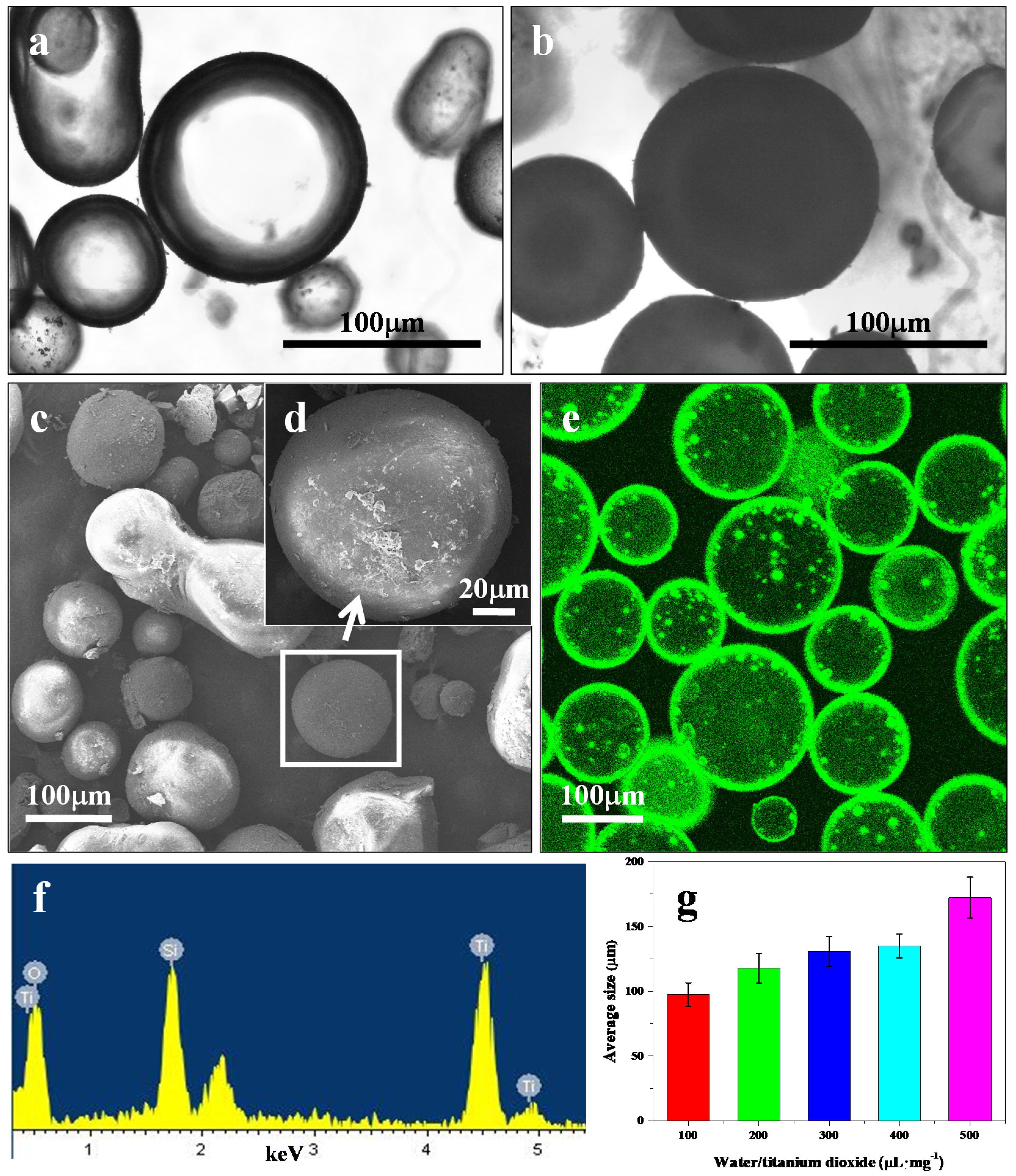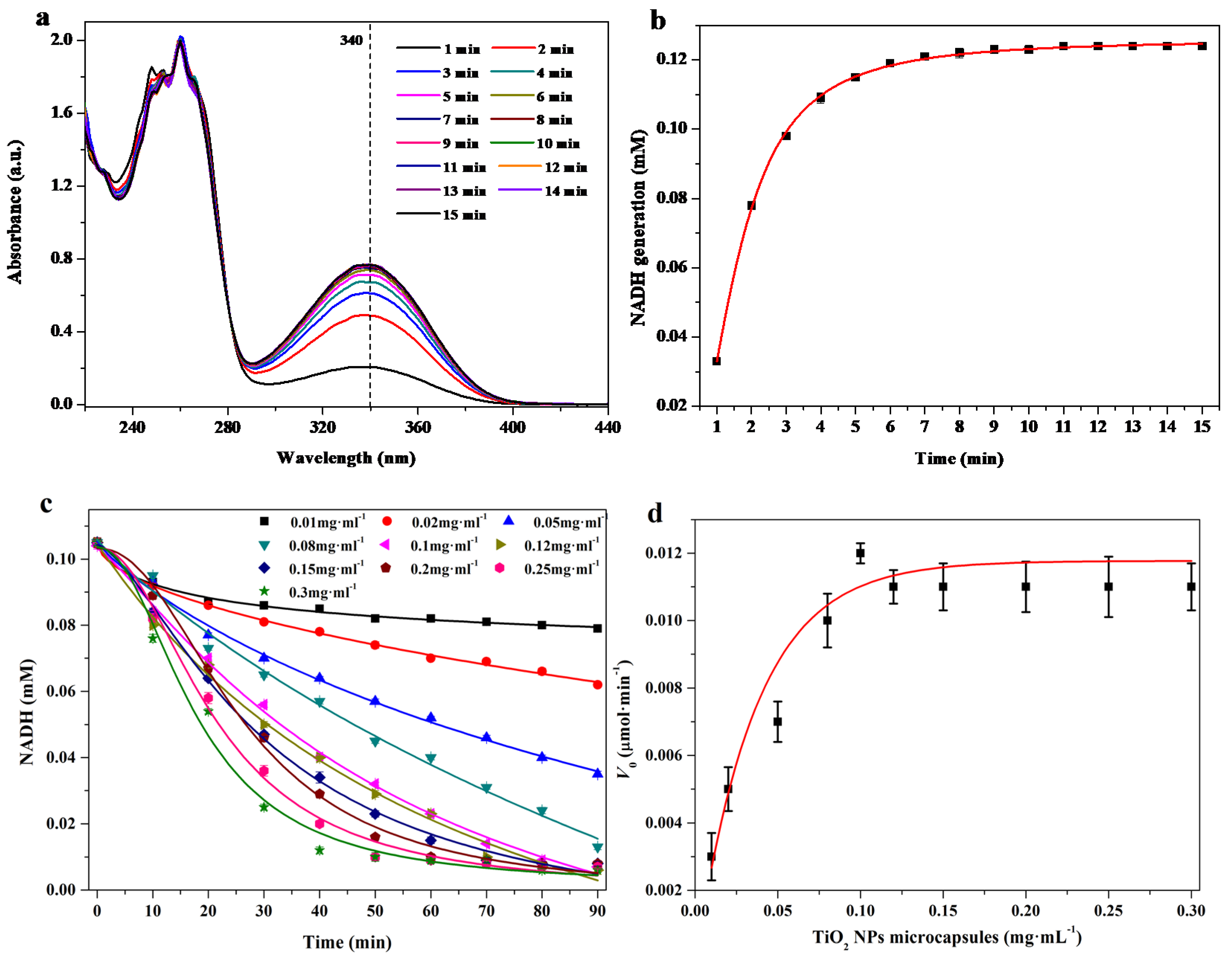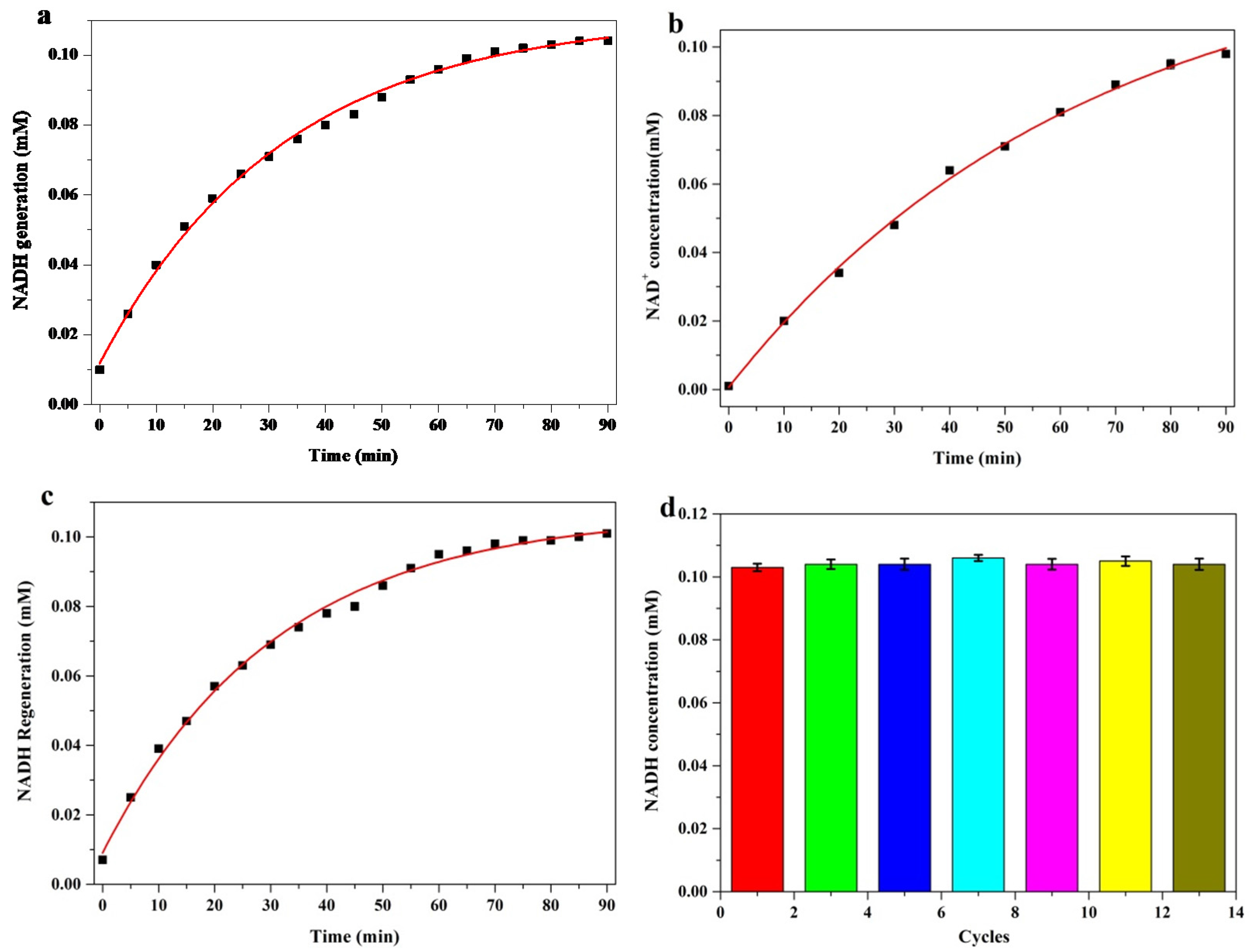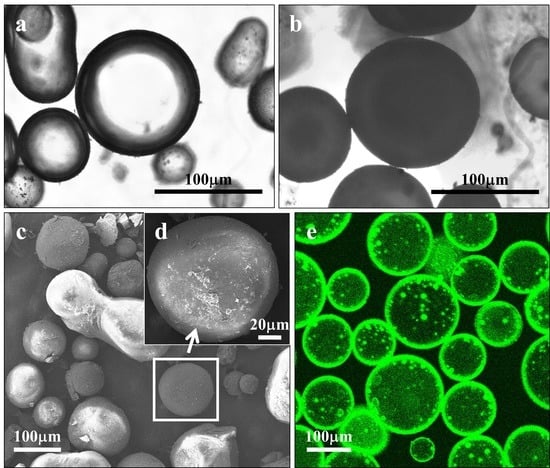Bioinspired Design of Alcohol Dehydrogenase@nano TiO2 Microreactors for Sustainable Cycling of NAD+/NADH Coenzyme
Abstract
1. Introduction
2. Materials and Methods
2.1. Materials
2.2. Preparation of PDA-Modified ADH@TiO2 NP Microreactors
2.3. NAD+/NADH Cycling Catalyzed by ADH@TiO2 NP Microreactors
2.4. Characterization
3. Results and Discussion
4. Conclusions
Supplementary Materials
Acknowledgments
Author Contributions
Conflicts of Interest
References
- Miller, D.M.; Gulbis, J.M. Engineering protocells: Prospects for self-assembly and nanoscale production-lines. Life 2015, 5, 1019–1053. [Google Scholar] [CrossRef] [PubMed]
- Yin, Y.; Lin, N.; Zhu, X.; Zhao, M.; Zhang, Z.; Mann, S.; Liang, D. Non-equilibrium behaviour in coacervate-based protocells under electric-field-induced excitation. Nat. Commun. 2016, 7, 10658. [Google Scholar] [CrossRef] [PubMed]
- Buddingh, B.C.; van Hest, J.C.M. Artificial cells: Synthetic compartments with life-like functionality and adaptivity. Acc. Chem. Res. 2017, 50, 769–777. [Google Scholar] [CrossRef] [PubMed]
- Marpani, F.; Pinelo, M.; Meyer, A.S. Enzymatic conversion of CO2 to CH3OH via reverse dehydrogenase cascade biocatalysis: Quantitative comparison of efficiencies of immobilized enzyme systems. Biochem. Eng. J. 2017, 127, 217–228. [Google Scholar] [CrossRef]
- Summers, D.P.; Rodoni, D. Vesicle encapsulation of a nonbiological photochemical system capable of reducing NAD+ to NADH. Langmuir 2015, 31, 10633–10637. [Google Scholar] [CrossRef] [PubMed]
- Jiang, B.B.; Wang, X.D.; Wu, D.Z. Fabrication of microencapsulated phase change materials with TiO2/Fe3O4 hybrid shell as thermoregulatory enzyme carriers: A novel design of applied energy microsystem for bioapplications. Appl. Energy 2017, 201, 20–33. [Google Scholar] [CrossRef]
- Li, J.D.; Liu, H.; Wang, X.D.; Wu, D.Z. Development of thermoregulatory enzyme carriers based on microencapsulated N-docosane phase change material for biocatalytic enhancement of amylases. ACS Sustain. Chem. Eng. 2017, 5, 8396–8406. [Google Scholar] [CrossRef]
- Sun, S.; Li, M.; Dong, F.; Wang, S.; Tian, L.; Mann, S. Chemical signaling and functional activation in colloidosome-based protocells. Small 2016, 12, 1920–1927. [Google Scholar] [CrossRef] [PubMed]
- Rodriguez-Arco, L.; Li, M.; Mann, S. Phagocytosis-inspired behaviour in synthetic protocell communities of compartmentalized colloidal objects. Nat. Mater. 2017, 16, 857–863. [Google Scholar] [CrossRef] [PubMed]
- Akkarachaneeyakorn, K.; Li, M.; Davis, S.A.; Mann, S. Secretion and Reversible Assembly of Extracellular-like Matrix by Enzyme-Active Colloidosome-Based Protocells. Langmuir 2016, 32, 2912–2919. [Google Scholar] [CrossRef] [PubMed]
- Zhang, S.; Jiang, Z.; Zhang, W.; Wang, X.; Shi, J. Polymer–inorganic microcapsules fabricated by combining biomimetic adhesion and bioinspired mineralization and their use for catalase immobilization. Biochem. Eng. J. 2015, 93, 281–288. [Google Scholar] [CrossRef]
- Wang, J.; Huang, R.; Qi, W.; Su, R.; He, Z. Oriented enzyme immobilization at the oil/water interface enhances catalytic activity and recyclability in a pickering emulsion. Langmuir 2017, 33, 12317–12325. [Google Scholar] [CrossRef] [PubMed]
- Hassan, M.M.; Atiqullah, M.; Beg, S.A.; Chowdhury, M.H.M. Effects of enzyme microcapsule shape on the performance of a nonisothermal packed-bed tubular reactor. J. Chem. Technol. Biot. 2015, 66, 41–55. [Google Scholar] [CrossRef]
- Zheng, Z.; Jin, J.; Xu, G.K.; Zou, J.; Wais, U.; Beckett, A.; Heil, T.; Higgins, S.; Guan, L.; Wang, Y. Highly stable and conductive microcapsules for enhancement of joule heating performance. ACS Nano 2016, 10, 4695–4703. [Google Scholar] [CrossRef] [PubMed]
- Li, Y.L.; Zhu, M.L.; Li, X.Y.; Li, X.H.; Jiang, Y. A highly expandable and tough polyacrylamide–alginate microcapsule. Rsc Adv. 2016, 6, 44896–44901. [Google Scholar] [CrossRef]
- Wang, S.; Li, M.; Patil, A.J.; Sun, S.; Tian, L.; Zhang, D.; Cao, M.; Mann, S. Design and construction of artificial photoresponsive protocells capable of converting day light to chemical energy. J. Mater. Chem. A 2017, 5, 24612–24616. [Google Scholar] [CrossRef]
- Huo, C.; Li, M.; Huang, X.; Yang, H.; Mann, S. Membrane engineering of colloidosome microcompartments using partially hydrophobic mesoporous silica nanoparticles. Langmuir 2014, 30, 15047–15052. [Google Scholar] [CrossRef] [PubMed]
- Chen, T.; Colver, P.J.; Bon, S.A.F. Organic-inorganic hybrid hollow spberes prepared from TiO2-stabilized pickering emulsion polymerization. Adv. Mater. 2007, 19, 2286–2289. [Google Scholar] [CrossRef]
- Lin, S.; Sun, S.; Shen, K.; Tan, D.; Zhang, H.; Dong, F.; Fu, X. Photocatalytic microreactors based on nano TiO2-containing clay colloidosomes. Appl. Clay Sci. 2017. [Google Scholar] [CrossRef]
- Uppada, V.; Bhaduri, S.; Noronha, S.B. Cofactor regeneration—an important aspect of biocatalysis. Curr. Sci. 2014, 106, 946–957. [Google Scholar]
- Jin, B.; Yao, G.; Wang, X.; Ding, K.; Jin, F. Photocatalytic oxidation of glucose into formate on nano TiO2 catalyst. ACS Sustain. Chem. Eng. 2017, 5, 6377–6381. [Google Scholar] [CrossRef]
- Sun, H.; Peng, T.; Liu, B.; Xian, H. Effects of montmorillonite on phase transition and size of TiO2 nanoparticles in TiO2/montmorillonite nanocomposites. Appl. Clay Sci. 2015, 114, 440–446. [Google Scholar] [CrossRef]
- Lv, K.; Perriman, A.W.; Mann, S. Photocatalytic multiphase micro-droplet reactors based on complex coacervation. Chem. Commun. 2015, 51, 8600–8602. [Google Scholar] [CrossRef] [PubMed]
- Mao, W.; Lin, X.; Zhang, W.; Chi, Z.; Lyu, R.; Cao, A.; Wan, L. Core-shell structured TiO2@polydopamine for highly active visible-light photocatalysis. Chem. Commun. 2016, 52, 7122–7125. [Google Scholar] [CrossRef] [PubMed]




© 2018 by the authors. Licensee MDPI, Basel, Switzerland. This article is an open access article distributed under the terms and conditions of the Creative Commons Attribution (CC BY) license (http://creativecommons.org/licenses/by/4.0/).
Share and Cite
Lin, S.; Sun, S.; Wang, K.; Shen, K.; Ma, B.; Ren, Y.; Fan, X. Bioinspired Design of Alcohol Dehydrogenase@nano TiO2 Microreactors for Sustainable Cycling of NAD+/NADH Coenzyme. Nanomaterials 2018, 8, 127. https://doi.org/10.3390/nano8020127
Lin S, Sun S, Wang K, Shen K, Ma B, Ren Y, Fan X. Bioinspired Design of Alcohol Dehydrogenase@nano TiO2 Microreactors for Sustainable Cycling of NAD+/NADH Coenzyme. Nanomaterials. 2018; 8(2):127. https://doi.org/10.3390/nano8020127
Chicago/Turabian StyleLin, Sen, Shiyong Sun, Ke Wang, Kexuan Shen, Biaobiao Ma, Yuquan Ren, and Xiaoyu Fan. 2018. "Bioinspired Design of Alcohol Dehydrogenase@nano TiO2 Microreactors for Sustainable Cycling of NAD+/NADH Coenzyme" Nanomaterials 8, no. 2: 127. https://doi.org/10.3390/nano8020127
APA StyleLin, S., Sun, S., Wang, K., Shen, K., Ma, B., Ren, Y., & Fan, X. (2018). Bioinspired Design of Alcohol Dehydrogenase@nano TiO2 Microreactors for Sustainable Cycling of NAD+/NADH Coenzyme. Nanomaterials, 8(2), 127. https://doi.org/10.3390/nano8020127





